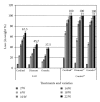Isolation, characterization, and identification of biological control agent for potato soft rot in Bangladesh
- PMID: 22645446
- PMCID: PMC3356727
- DOI: 10.1100/2012/723293
Isolation, characterization, and identification of biological control agent for potato soft rot in Bangladesh
Abstract
A total of 91 isolates of probable antagonistic bacteria of potato soft rot bacterium Erwinia carotovora subsp. carotovora (Ecc) were extracted from rhizospheres and endophytes of various crop plants, different soil varieties, and atmospheres in the potato farming areas of Bangladesh. Antibacterial activity of the isolated probable antagonistic bacteria was tested in vitro against the previously identified most common and most virulent soft rot causing bacterial strain Ecc P-138. Only two isolates E-45 and E-65 significantly inhibited the in vitro growth of Ecc P-138. Physiological, biochemical, and carbon source utilization tests identified isolate E-65 as a member of the genus Bacillus and the isolate E-45 as Lactobacillus sp. The stronger antagonistic activity against Ecc P-138 was found in E-65 in vitro screening and storage potatoes. E-65 reduced the soft rot infection to 22-week storage potatoes of different varieties by 32.5-62.5% in model experiment, demonstrating its strong potential to be used as an effective biological control agent for the major pectolytic bacteria Ecc. The highest (62.5%) antagonistic effect of E-65 was observed in the Granola and the lowest (32.7%) of that was found in the Cardinal varieties of the Bangladeshi potatoes. The findings suggest that isolate E-65 could be exploited as a biocontrol agent for potato tubers.
Figures




References
-
- Czajkowski R, Perombelon MCM, van Veen JA, van der Wolf JM. Control of blackleg and tubersoft rot of potato caused by Pectobacterium and Dickeya species: a review. Plant Pathology. 2011;10:1365–3059.
-
- Agrios GN. Plant Pathology. 4th edition. San Diego, Calif, USA: Academic Press; 1997. Control of plant diseases; pp. 200–216.
-
- Xu GW, Gross DC. Selection of fluorescent pseudomonads antagonistic to Erwinia carotovora and suppressive of potato seed piece decay. Phytopathology. 1986;76:414–422.
-
- Abdelghafar NY, Abdelsayed WM. Biological control of bacterial soft rot of potato by using flurescent pseudomonads. Arab Universities Journal Agricultural Science. 1997;5(2):419–431.
-
- Sturz AV, Matheson BG. Populations of endophytic bacteria which influence host-resistance to Erwinia-induced bacterial soft rot in potato tubers. Plant and Soil. 1996;184(2):265–271.
Publication types
MeSH terms
Substances
LinkOut - more resources
Full Text Sources

